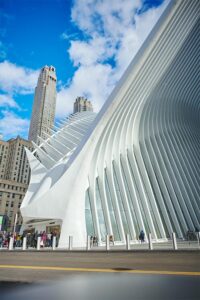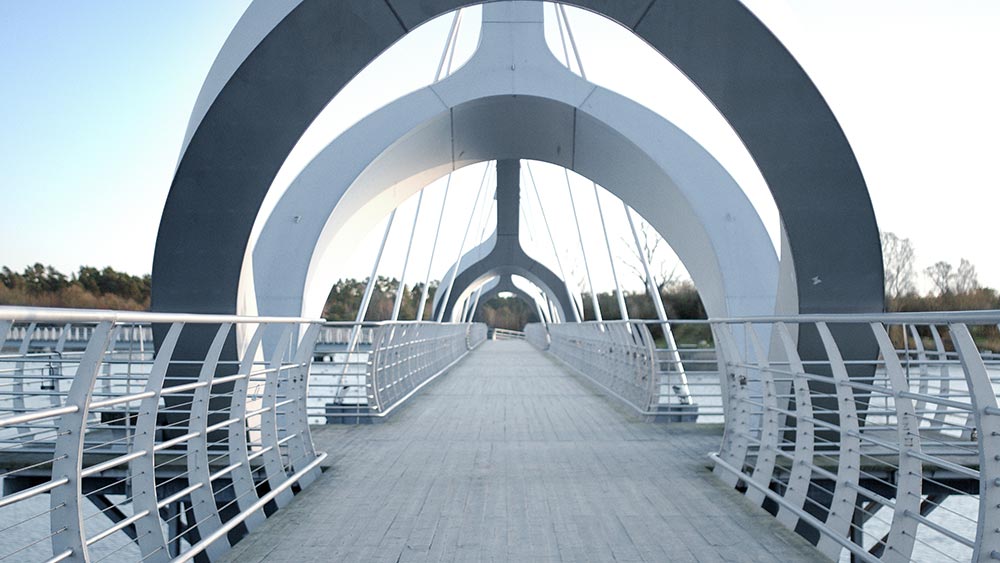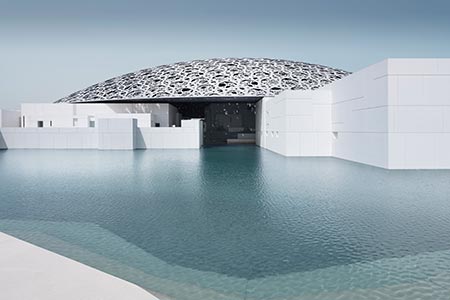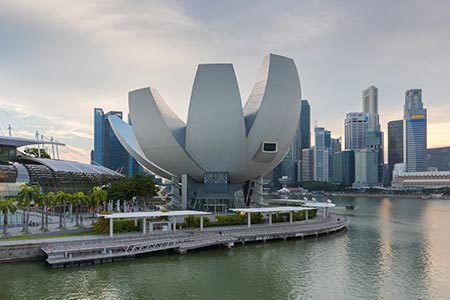Despite the recent disruption to the world economy caused by Covid-19, many governments have ambitious plans to boost infrastructure spending as economies grow and concerns about global warming stimulate interest in “smart” cities. Also, many recent examples of stainless steel used in architecture show that architects are keen to explore its almost infinite possibilities. But questions remain: Will these plans meet opposition? Given the rising cost of raw materials, are they economically viable?
By James Chater
ABC
Architecture, Building & Construction (ABC) is extremely sensitive to economic vicissitudes. So it will be no surprise that the global pandemic that started last year caused a rapid downturn in the sector’s activity. With many projects on hold and tourism badly hit, there is no appetite for new hotels or office blocks. However, some sectors have fared relatively well: affordable housing and suburban housing. Either because of Covid-19, or because inner-city prices had climbed too high anyway, demand has increased for lower-density domestic housing away from city centres. Moreover, the pandemic has caused a rise in people working from home, which requires more spacious houses. This trend is likely to outlive the current pandemic. The virus may also have driven a rise in digitalization: several homes are now being 3D-printed, saving labour and raw materials costs (see below).
Architecture and 3D printing
Architecture and construction are some of the last sectors to be affected by the arrival of 3D printing. Several houses have already been 3D-printed, and the savings in terms of speed, labour and materials are considerable. The materials most often used include earth and concrete. When it comes to stainless steel, the most notable example to date is a 3D-printed stainless-steel pedestrian and cyclist bridge, designed by MX3D, over a canal in Amsterdam. Other examples are likely to follow. For example, Arup has developed a method to 3D-print complex structural steel components for construction projects.
Rising costs
This brings us to another factor that could cause a dent in future activity.The price of raw materials is rising rapidly, including metals like nickel and molybdenum that are important ingredients of stainless steel. Stainless steel prices have therefore been rising (for example, cold-rolled 304 hit a nine-year high in 2021 Q2), as have carbon steel prices. In addition, there is an overall shortage of materials used in building, especially timber, that could raise construction costs and property prices.
Megaprojects
Rising costs and also possible resistance from Congress are two elements that threaten to derail President Biden’s ambitious plan to renew US infrastructure. If Biden gets his way, 2 trillion USD will be spent over eight years to renew infrastructure and reshape the economy. This would include fixing 20,000 miles of roads and 10,000 bridges; insulating houses; updating water supplies, the electric grid and transport; and shifting to renewable energy resources. Meanwhile, the EU has put in place a recovery plan worth 750 billion euros to help overcome the economic effects of Covid-19, designed to make Europe “greener, more digital and more resilient.”
Even before Covid-19, many countries, especially in Asia and Africa, have been developing ambitious infrastructure plans. The “smart city” initiative, harnessing green energy, AI and IoT, affects many of the world’s capitals; Saudi Arabia is building one from scratch (NEOM), while India is planning 100 of them! Other cities (Egypt’s proposed new capital, India’s Navi Mumbai, Nigeria’s Centenary City), transport (the California High-Speed Rail, the China–Pakistan Economic Corridor, the Tel Aviv Light Rail, the Grand Paris Express), airports (Al Maktoum International, Dubai, under construction at a cost of 82 billion USD), industrial zones (the Delhi Mumbai Industrial Corridor) – these are just some of the more expensive projects planned. All these will require large amounts of stainless steel, whether for street furniture (benches, railings, escalators, lifts, etc.); plumbing, waste/water management; for structural support (rebar), or for any “iconic” buildings that may be planned (plate, mesh, tubes).

India’s construction boom
India has one of the most dynamic ABC markets in the world. The country’s residential, commercial, retail and entertainment real estate sectors are growing rapidly, and several special industrial zones are being developed. All types of transit buildings – rail, airports (50 new ones planned!), metros, buses – are using stainless steel, and it is being applied extensively in urban furniture and equipment such as gates, railings, bus shelters, trains, escalators, lifts, benches and canopies. A number of new “smart cities” are also planned. The growth potential is enormous given that per capita consumption stands at only at 2.1kg, well below the world average of 6kg.
Stainless advantage

The advantages of using any type of steel in construction are well known: strength, durability, varieties of finishing, chrome appearance. Stainless steel brings additional advantages: resistance to corrosion and pollution, low maintenance, a more favourable strength-to-weight ratio (especially in the case of duplex), and colour (obtained by manipulating the oxide zone). Because most new building will take place in coastal regions, the most sought-after grade (judging from recent examples) is the saline-resistant 316(L), though the less corrosion-resistant 304 may also be found. Less frequent is duplex, except where high strength-to-weight and structural support are required. Recently we have seen a spate of footbridges built in duplex, for example.
Aesthetics and function
Wherever stainless is visible (rather than when used in water pipes or in rebar), a combination of practical and aesthetic considerations comes into play. A good case in point is the way stainless-steel mesh is used in modern buildings. The new campus of the Houston Area Safety Council, in Pasadena, near Houston, has rooftop canopies made of mesh that provides protection from the sun while allowing unrestricted views of the campus.

Did you know?
Jo Biden is not the first US president to launch an ambitious programme of infrastructure spending. Franklin Roosevelt’s New Deal is a notable predecessor, as is the work of one fictional president, Thomas Kirkman, in the Netflix series Designated Survivor. Kirkman’s programme fails to obtain congressional approval, so is funded by the private sector. It proves popular enough to allow Kirkman to gain a second term. How will Biden’s plan fare in comparison?



A similar function is performed by the 70 mesh panels attached to the parking deck of the new Samsung America Headquarters in San José . On the outside, the mesh conceals the interior and reflects the sunlight; in the interior, it protects against sun, wind and rain. Stainless steel plays an important role in many buildings that are “iconic”, i.e. are designed to make a statement and use symbolism and allusions to comment on their surroundings. The World Trade Center Transportation Hub in New York City is designed to resemble a bird taking flight. At the same time a lean duplex grade from Outokumpu was specified for the “wings” because of its strength and its ability to act as a thermal barrier. Symbolism is also present in Le Berlingot (Nantes, France) office buildings, whose layered design mimics the striped hard candies that the city is famous for. The stainless steel on the façade is in 304, supplied by Uginox. An especially fine example of how stainless steel can provide shelter from the sun while creating fascinating patterns is the Louvre Abu Dhabi, where duplex stainless steel is made to resemble basket weave in a
“nebula of stars”, with the sun filtering in, causing interesting pools of light. Another public building that reflects its environment is the ArtScience Museum at Marina Bay Sands in Singapore. Located by a lily pond, its design is in the form of a flower with 10 petals that rise to different heights, giving the impression the whole structure is tilted. The museum is clad
in FRP skin, while the vertical sides of each petal are sheathed in bead-blasted stainless-steel panels. Another building that comments on its environment is the vibrant Museum at Prairiefire in Kansas, USA. The riot of colours, in which red dominates, refers to the custom of controlled prairie burns that are carried out to eliminate invasive plant species and return the soil to fertility. The stainless-steel panels and dichroic glass shift in hue depending on the angle of view, reminiscent of dancing and leaping flames.
Conclusion
As time goes on, more examples emerge of buildings that make creative use of stainless steel, and with varying types of finish combined with water and lighting, and with the variation provided by the elements and the different times of day, the possibilities seem endless. And even if only a small number of the planned megaprojects see the light of day, the use of stainless steel on architecture is assured.
Every week we share a new Featured Story with our Stainless Steel community. Join us and let’s share your Featured Story on Stainless Steel World online and in print.


